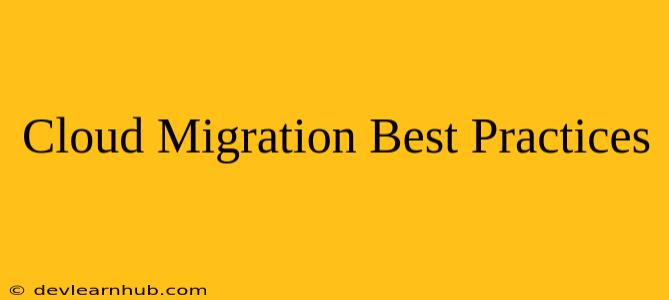Migrating to the cloud can be a complex and challenging process, but it can also be a rewarding one. By following the right best practices, you can ensure that your migration is successful and that you achieve your desired results.
Plan Your Migration
Before you start migrating your applications and data to the cloud, it's important to plan your migration carefully. This includes:
- Define your goals. What are you hoping to achieve by migrating to the cloud? Reduced costs? Improved performance? Increased scalability?
- Choose the right cloud provider. There are many different cloud providers available, each with its own strengths and weaknesses. Do your research and choose the provider that best meets your needs.
- Select the right migration strategy. There are several different migration strategies you can choose from, including lift-and-shift, re-platforming, and re-architecting. Choose the strategy that is best suited for your specific needs.
- Develop a migration plan. This plan should include timelines, milestones, and resources.
- Get buy-in from stakeholders. Make sure everyone involved in the migration understands the process and is on board with the plan.
Assess Your Applications and Data
Once you have a plan in place, you need to assess your applications and data to determine what needs to be migrated. This includes:
- Identify all of your applications and data.
- Determine the dependencies between applications and data.
- Assess the compatibility of your applications and data with the cloud provider you've chosen.
- Estimate the amount of data you need to migrate.
- Develop a data migration strategy.
Test and Deploy
Once you have migrated your applications and data to the cloud, it's important to test them thoroughly to ensure that everything is working as expected. This includes:
- Perform functional and performance testing.
- Monitor your applications and data in the cloud.
- Make any necessary adjustments.
- Deploy your applications and data to the cloud.
Optimize and Manage
Once your applications and data are deployed to the cloud, you need to optimize and manage them to ensure they are running efficiently and effectively. This includes:
- Monitor your cloud environment.
- Identify and resolve any issues.
- Optimize your cloud resources.
- Implement security measures.
- Automate tasks.
Key Takeaways
Migrating to the cloud can be a complex process, but by following these best practices, you can increase your chances of success. Remember to:
- Plan your migration carefully.
- Assess your applications and data.
- Test and deploy your applications and data.
- Optimize and manage your cloud environment.
By following these best practices, you can ensure that your cloud migration is successful and that you achieve your desired results.
